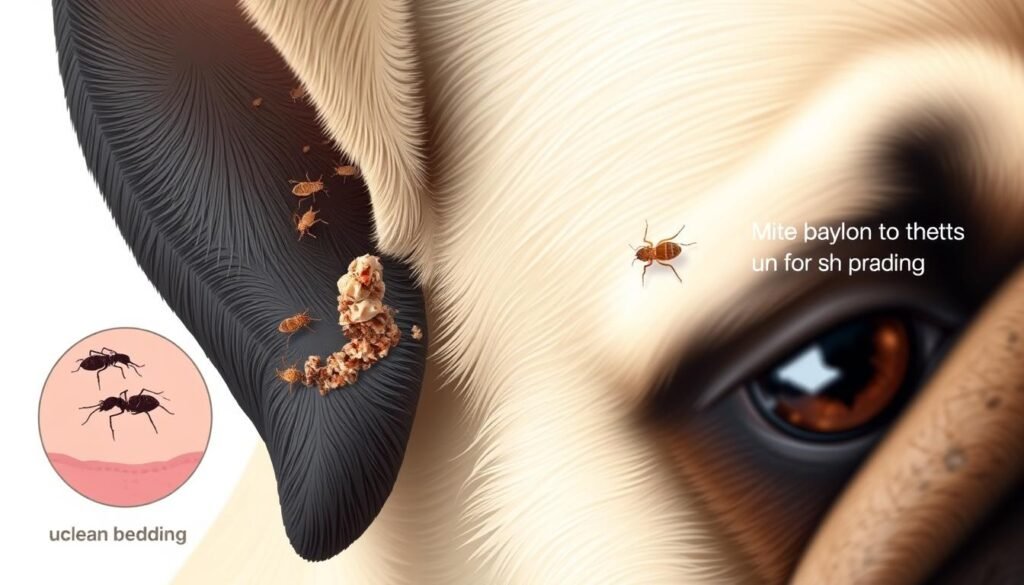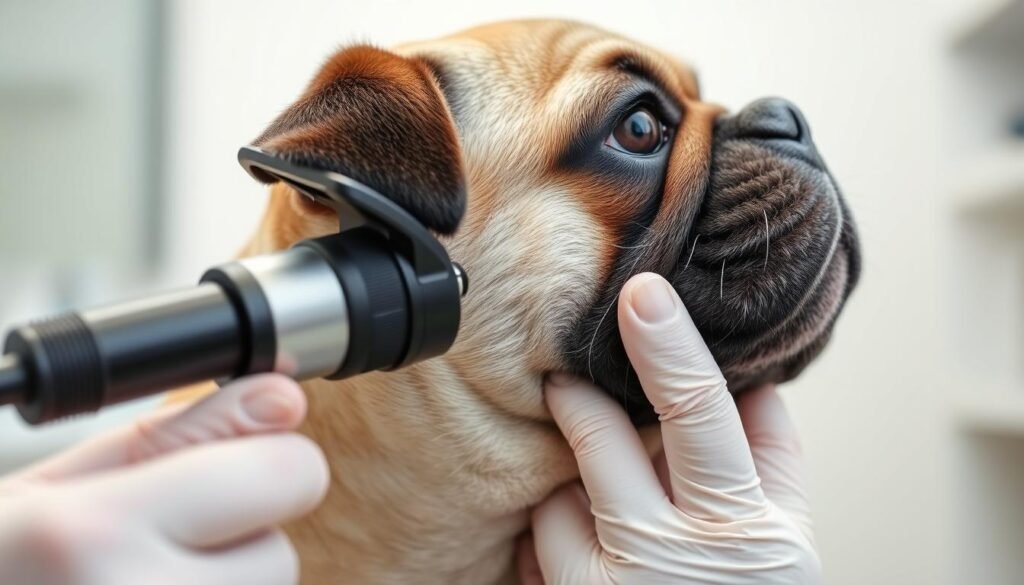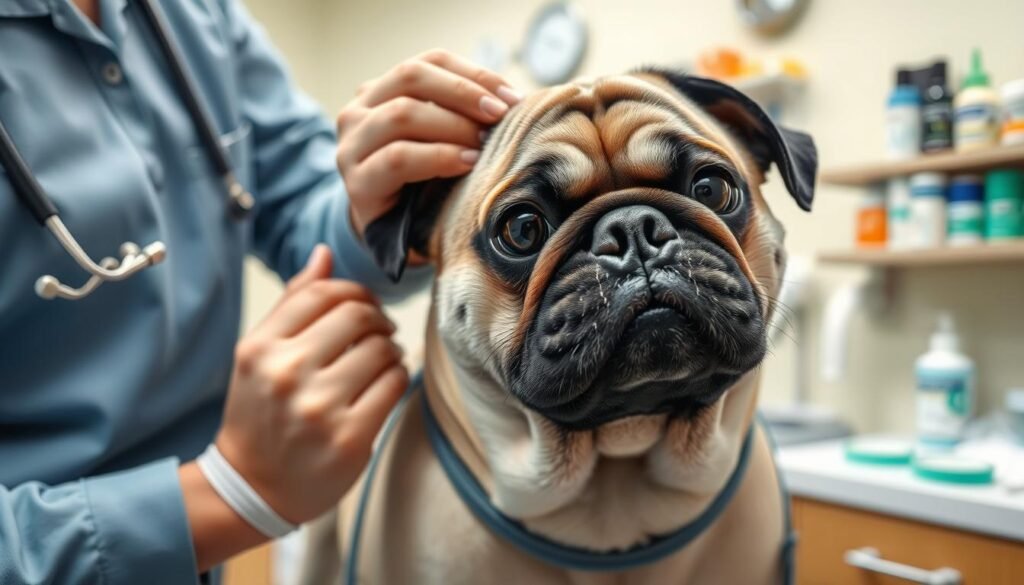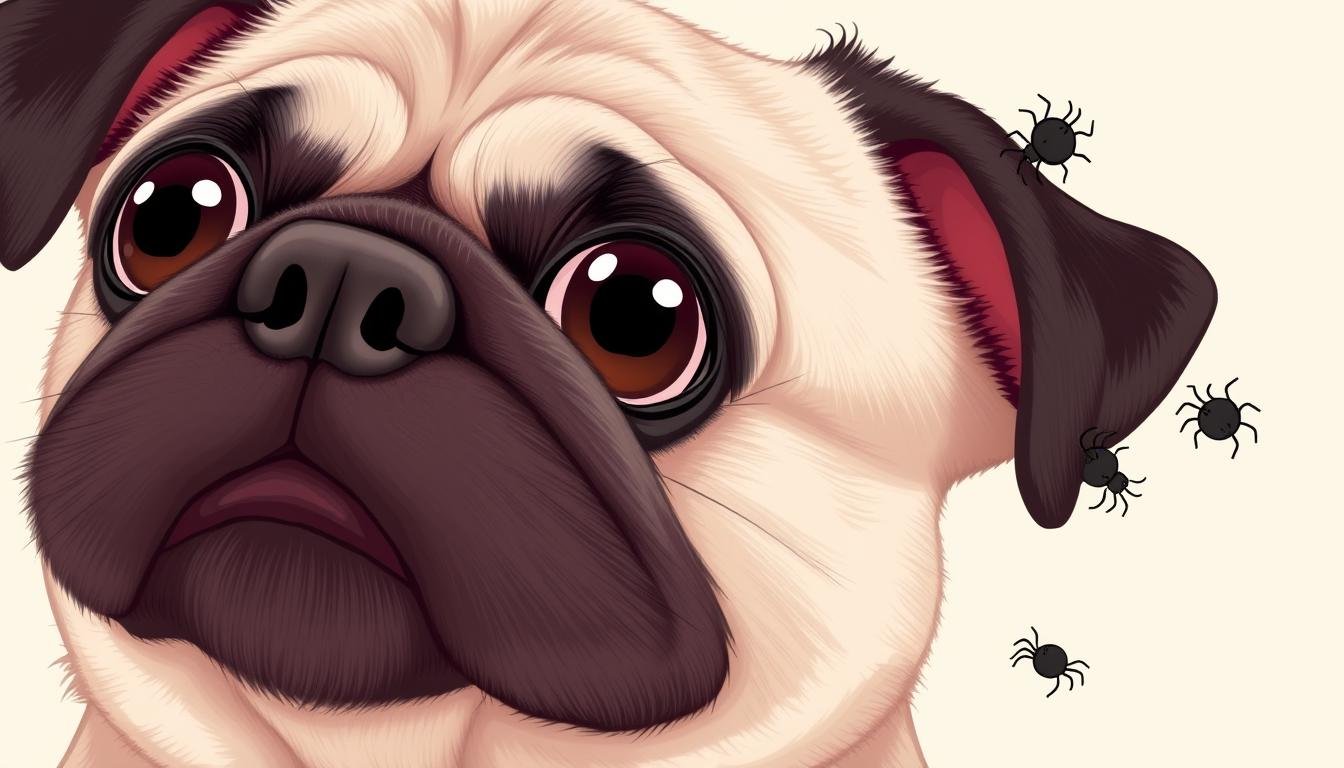How to avoid ear mite infestations in Pugs
Ear mites are a common problem for Pug owners. These tiny parasites can cause irritation, inflammation, and even infections in your dog’s ears. But don’t worry, there are ways to keep your Pug’s ears safe from these pests.
This guide will help you understand ear mites in Pugs. You’ll learn about their causes, symptoms, how to diagnose them, and how to treat and prevent them. With this knowledge, you can keep your Pug’s ears healthy and free from mites.
What Are Ear Mites in Dogs?
Ear mites, also known as Otodectes cynotis, are tiny parasites. They live in the ear canals of dogs, cats, and other animals. These tiny creatures feed on the wax and oils in the ear canal. This causes irritation and discomfort for your Pug.
Understanding the Tiny Parasites
Ear mites in dogs are small, spider-like creatures. They can infect both ears. They live in the dog’s ear canal, multiply quickly, and feed on the ear’s natural secretions.
Left untreated, these mites can cause secondary infections. They can even lead to hearing loss in severe cases.
Symptoms of Ear Mites in Pugs
- Head shaking and excessive scratching around the ears
- Dark, waxy ear discharge with an unpleasant odor
- Redness, inflammation, and irritation in the ear canal
- Hair loss around the affected ear(s)
If you see any of these ear mite symptoms in pugs, get your Pug to a vet fast. Quick treatment is key to stop further problems and keep your pet comfortable.

Causes of Ear Mite Infestations in Pugs
Ear mite infestations in Pugs often come from being close to other infected pets. These tiny parasites are about 1-2 millimeters long. They can move from one animal to another through contact or shared spaces like bedding or toys. Pugs that go outside a lot or are near other animals are more likely to get ear mites.
Dirty or crowded places can also help ear mites spread. Younger dogs, especially puppies, are more likely to get ear mites. This is because these mites are more common in younger pets.
Close Contact with Infected Pets
- Ear mites can easily transfer from one pet to another through direct contact or shared living spaces.
- Pugs that spend a lot of time around other dogs or cats are at a higher risk of developing ear mite infestations.
- Monthly preventative treatments like NexGard® for Dogs or NexGard SPECTRA® for Dogs can help control and prevent ear mite infestations.
Environmental Factors
- Dirty or crowded living conditions can create an ideal environment for ear mites to thrive.
- Ear mite infestations are more common in puppies and younger dogs, as their immune systems are still developing.
- Regular cleaning and grooming can help reduce the risk of ear mite infestations in Pugs.
Understanding why Pugs get ear mites helps owners prevent and treat them. It’s important to talk to a vet for the right treatment. This can include topical or oral meds to get rid of ear mites and stop them from coming back.

“Ear mites are a common problem in dogs, but they can be effectively treated with the right approach. The key is to work closely with your veterinarian to ensure your pug gets the proper care and prevention to keep these parasites at bay.”
How to Avoid Ear Mite Infestations in Pugs
Keeping your Pug’s ears healthy is key for their happiness. To stop ear mites, follow these steps:
- Keep your Pug away from other pets with ear mites. Ear mites spread fast between animals. So, it’s smart to keep your Pug away from infected dogs, cats, or other pets.
- Wash your Pug’s bedding, toys, and other items in hot water. This kills any mites that might be there. Remember to use a tumble dryer to get rid of all parasites.
- Give your Pug monthly doses of preventative meds like NexGard® for Dogs or NexGard SPECTRA® for Dogs. This protects them from ear mites and other parasites.
By following these steps, you can stop ear mites in dogs. This keeps your Pug’s ears healthy and happy. Regular vet visits and grooming are also important for their ear health and to prevent future problems.
“Preventing ear mite infestations in Pugs is crucial for their well-being and comfort. With the right preventative measures, you can keep your furry friend happy and healthy.”
Diagnosing Ear Mites in Pugs
If you think your Pug has ear mites, it’s important to see a vet. The vet will use an otoscope to look into your Pug’s ear. They will check for mites or signs of inflammation.
Ear Cytology Test
Your vet might also do an ear cytology test. This test takes a small sample from the ear and looks at it under a microscope. It helps confirm if ear mites are present.
Ear mites are tiny and can spread easily, especially in green areas. Signs of ear mites in Pugs include brown or black ear wax, a bad smell, and ear inflammation. They might also have debris in their ears, hair loss, and scratch a lot.

It’s key to tell ear mites apart from other ear problems in Pugs. Ear mites are a common cause of red, irritated ears in Pugs, says the Companion Animal Parasite Council.
Treatment Options for Ear Mites in Pugs
If your Pug has ear mites, your vet will suggest a treatment plan. This usually includes two main steps to get rid of the mites.
Ear Cleaning and Medication
The first thing to do is clean your Pug’s ears well. This removes any dirt or buildup from the mites. Your vet might give you ear drops or ointments to kill the mites. You’ll need to use these daily or as told, to make sure all mites are gone.
Topical and Oral Preventatives
Your vet might also suggest using NexGard® for Dogs or NexGard SPECTRA® for Dogs. These can help treat and prevent ear mites. It’s important to stick to the treatment plan your vet gives you.
Always finish the treatment, even if your Pug seems better. Ear mites can be hard to get rid of, and not finishing treatment can cause them to come back. By following your vet’s advice, you can help your Pug get better and avoid future problems.

“Ear mites are highly contagious, and it’s important to treat all pets in the household to prevent the spread and re-occurrence of the infestation.”
Recovery and Management After Treatment
After treating your pug for ear mites, it’s key to watch their recovery closely. This helps prevent future infestations. Good follow-up care is vital for getting rid of these parasites completely.
Follow-up Visits with Your Vet
Most dogs get better with one treatment, but sometimes more is needed. Your vet will check your pug’s ears again to make sure the mites are gone.
At these check-ups, your vet will look at your pug’s ears and do tests. They’ll see if the first treatment worked. If not, they might suggest more medicine or changes to the plan.
Keeping your pug’s ears clean and using any recommended prevention is important. Your vet can tell you the best ways to keep your pug’s ears healthy and free from mites.
“Proper management and full compliance with treatment instructions are essential for the recovery and management of ear mites in dogs.”
By following your vet’s advice and sticking to their treatment plan, you can help your pug recover well. This will keep their ears healthy and improve their overall well-being.
Preventing Future Ear Mite Infestations
To keep your Pug’s ears healthy, it’s key to clean and groom them regularly. Cleaning their ears weekly and grooming their coat helps remove debris. This reduces the chance of mite infestations. Also, using products like NexGard® for Dogs or NexGard SPECTRA® for Dogs all year round protects against ear mites and other parasites.
Regular Ear Cleaning and Grooming
Cleaning your Pug’s ears regularly is vital to prevent mites. Use a damp cloth or vet-approved ear cleaner to remove debris and wax. Also, grooming their coat prevents mats and dirt buildup, which can attract mites.
Year-Round Parasite Prevention
Using products like NexGard® for Dogs or NexGard SPECTRA® for Dogs all year round protects your Pug. These monthly treatments kill and repel ear mites, fleas, and ticks. They offer complete protection for your pet.
By being proactive with ear care and parasite prevention, you can keep your Pug’s ears healthy for years. Remember, a bit of prevention can make a big difference in your Pug’s happiness and health.
“Ear mites are highly contagious among dogs, cats, and ferrets, necessitating the treatment of all susceptible animals in the household and regular washing of pets’ toys and bedding.”
Can Humans Get Ear Mites from Dogs?
If you own a Pug, you might wonder if ear mites from your dog can infect you. The good news is that it’s very unlikely for humans to catch ear mites from dogs. Ear mites that affect dogs are different from those that can affect humans.
But, in rare cases, if a dog’s ear mite were to land on a person, it might cause some itchiness or a mild rash. A study found that 50 out of 65 people at risk of getting mites from infected animals showed skin issues. Most of these issues were on the arms and torso.
Most cases where humans got skin diseases from animals were checked because the owner was worried. The best way to prevent this is to treat and prevent ear mites in your Pug.
“Ear mites are highly contagious parasites that can affect both cats and dogs, with both being susceptible to infestation.”
While it might worry you to think about getting ear mites from your dog, it’s very unlikely. The best way to keep you and your Pug safe is to treat and prevent ear mites.
Differentiating Ear Mites from Other Ear Issues
As a Pug owner, knowing the difference between ear mites and other ear problems is key. Ear mites can be a big problem, but it’s important to tell them apart from ear wax buildup or infections.
Ear Mites vs. Ear Wax
Ear wax, or cerumen, is normal and healthy for Pugs. But, too much thick, dark, or waxy discharge might mean ear mites or another issue. It’s best to have a vet check your Pug’s ears to find out.
Ear Mites vs. Ear Infections
Ear infections, caused by bacteria or yeast, can look like ear mites. They might cause redness, inflammation, discharge, and discomfort. The only way to know for sure is a vet’s exam and possibly an ear cytology test.
If your Pug’s ear health changes, see a vet. Proper diagnosis and treatment are key to fixing ear issues and avoiding more problems. Knowing the differences helps you take care of your Pug better.

